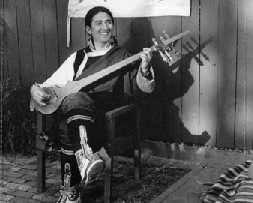| Music
Along with religion, food, celebrations, and dress, of course, music
is a way that people around the world express themselves and their unique
cultures.
 Tibet
has been described as “the sea of dance” or a “village of music.”
Always, music comes from, and reflects upon, the lives and spirits of the
people. You might even think of it as something like an emblem or
an identification badge. Tibet is no different: its music has its
own life and spirit that tells us about the people. Just as the region
includes many varied climates, terrains, and lifestyles, the music is similarly
diverse. Folk music in Tibet takes many different forms. A
song sung by a herdsman taking care of his flock might be just an unbroken
chain of hummed melodies. On the high mountains we might hear the
sound of a drum from afar. Why do you think a drum or flute might be better
suited to high altitudes? There are work songs, children’s
songs and mountain and pastoral songs. In the American culture there
are many work songs. Think about “The Erie Canal” or “Pick a Bale
of Cotton.” Like Americans, Tibetan people sing about the work that
is peculiar to that climate and experiences. Drinking songs are very popular,
expecially during fun celebrations like Losar (New Years) or weddings.
One person will accompany and all will join in. Tibet
has been described as “the sea of dance” or a “village of music.”
Always, music comes from, and reflects upon, the lives and spirits of the
people. You might even think of it as something like an emblem or
an identification badge. Tibet is no different: its music has its
own life and spirit that tells us about the people. Just as the region
includes many varied climates, terrains, and lifestyles, the music is similarly
diverse. Folk music in Tibet takes many different forms. A
song sung by a herdsman taking care of his flock might be just an unbroken
chain of hummed melodies. On the high mountains we might hear the
sound of a drum from afar. Why do you think a drum or flute might be better
suited to high altitudes? There are work songs, children’s
songs and mountain and pastoral songs. In the American culture there
are many work songs. Think about “The Erie Canal” or “Pick a Bale
of Cotton.” Like Americans, Tibetan people sing about the work that
is peculiar to that climate and experiences. Drinking songs are very popular,
expecially during fun celebrations like Losar (New Years) or weddings.
One person will accompany and all will join in.
 Another
form of music that we can think about is opera. In Tibet it is called
Lhamo. As the opera in China, It is a very ancient and exciting tradition
with beautiful costumes and masks.The female singers are trained to sing
very high with wavering notes. Some people think that it began
in the 8thh century when folk songs and dances were adapted to tell
the stories of Buddha. Others think it began in the 14th century
when a monk took folk songs and dances and added stories from Buddhist
meditations to instill a love of doing good and a delight in giving. More
information about Tibetan Opera is available at http://www.tibet.net/eng/tipa/lhamo. Another
form of music that we can think about is opera. In Tibet it is called
Lhamo. As the opera in China, It is a very ancient and exciting tradition
with beautiful costumes and masks.The female singers are trained to sing
very high with wavering notes. Some people think that it began
in the 8thh century when folk songs and dances were adapted to tell
the stories of Buddha. Others think it began in the 14th century
when a monk took folk songs and dances and added stories from Buddhist
meditations to instill a love of doing good and a delight in giving. More
information about Tibetan Opera is available at http://www.tibet.net/eng/tipa/lhamo.
Buddhist monks are famous for their throat singing, for their
chanting, and for playing trumpets, drums and gongs. These instruments
are thought to be loud enough to chase evil spirits away.
There are many instruments used in the religious rituals and celebrations.
If you would like to have the instruments identified and hear how they
sound, click to:
http://www.diamondway-buddhism.org/terms/music.htm.
If you play an instrument, which Tibetan instrument is most like yours?
There is much more to be learned about Tibet and its music. This
site has just given you some ideas
We’ve seen that Tibetan music is a reflection of Tibetan life.
In a larger sense music can be a reflection of any culture. In learning
about the music, we learn something of people themselves. Everywhere
people sing and dance.
|